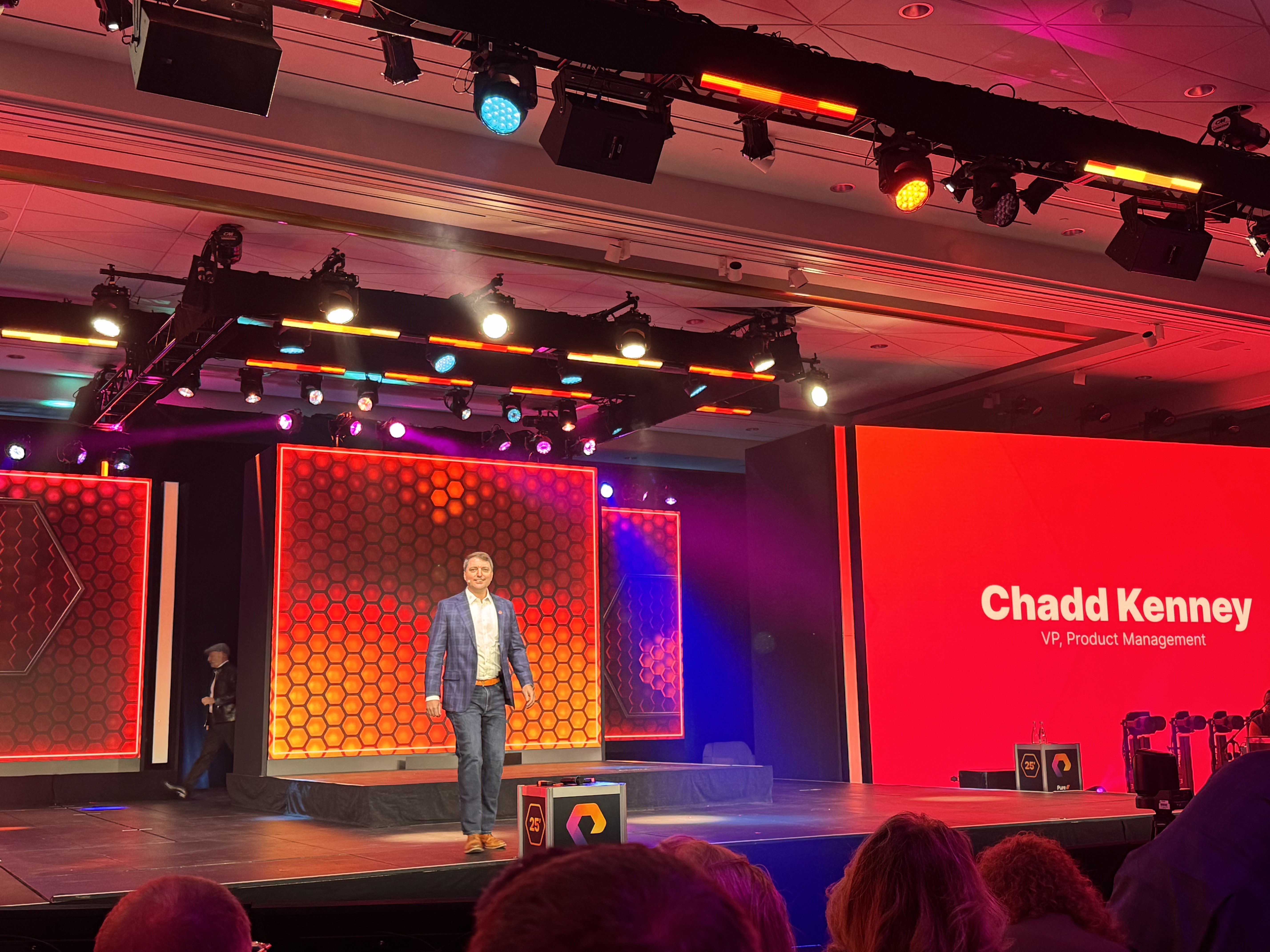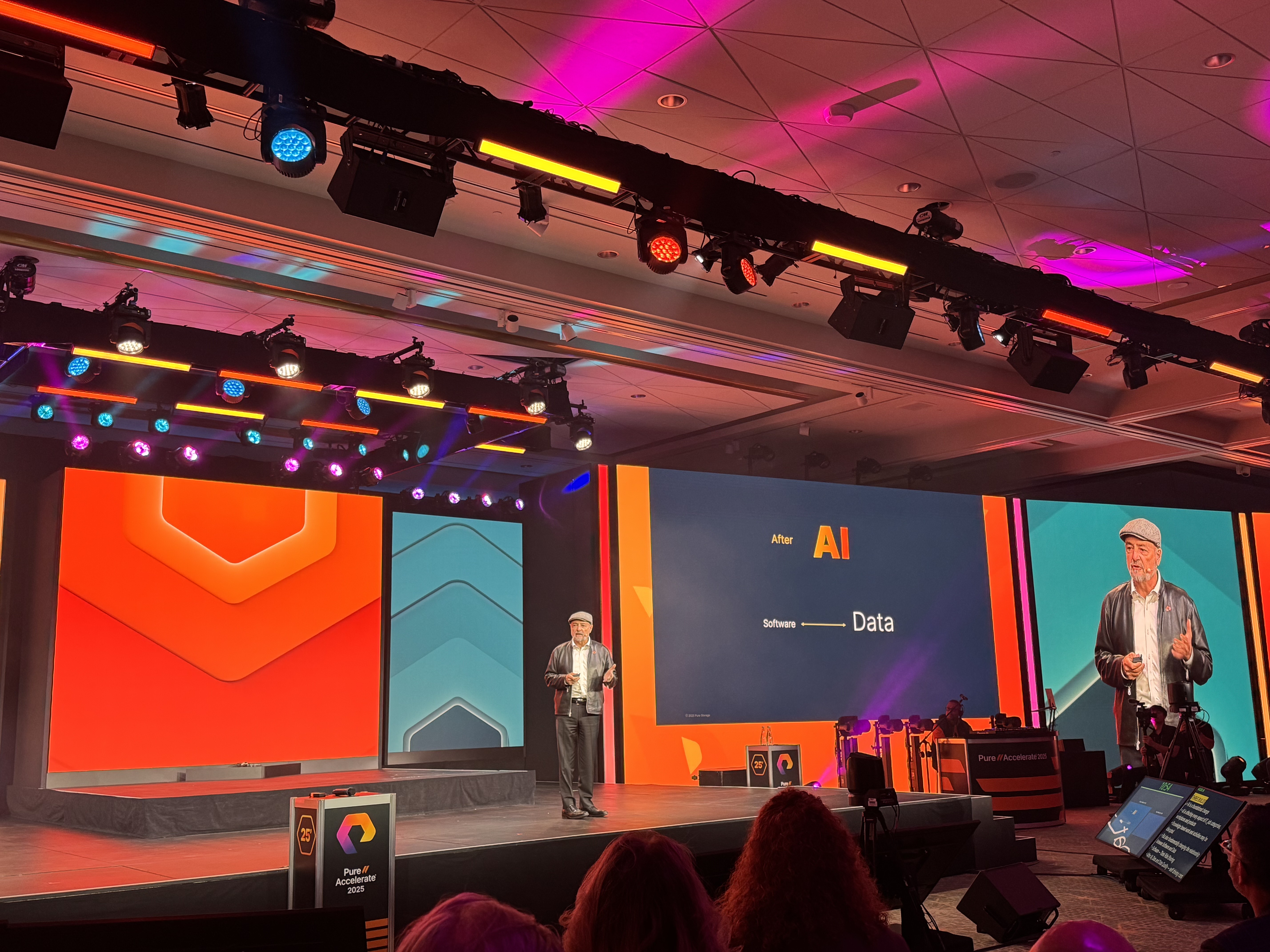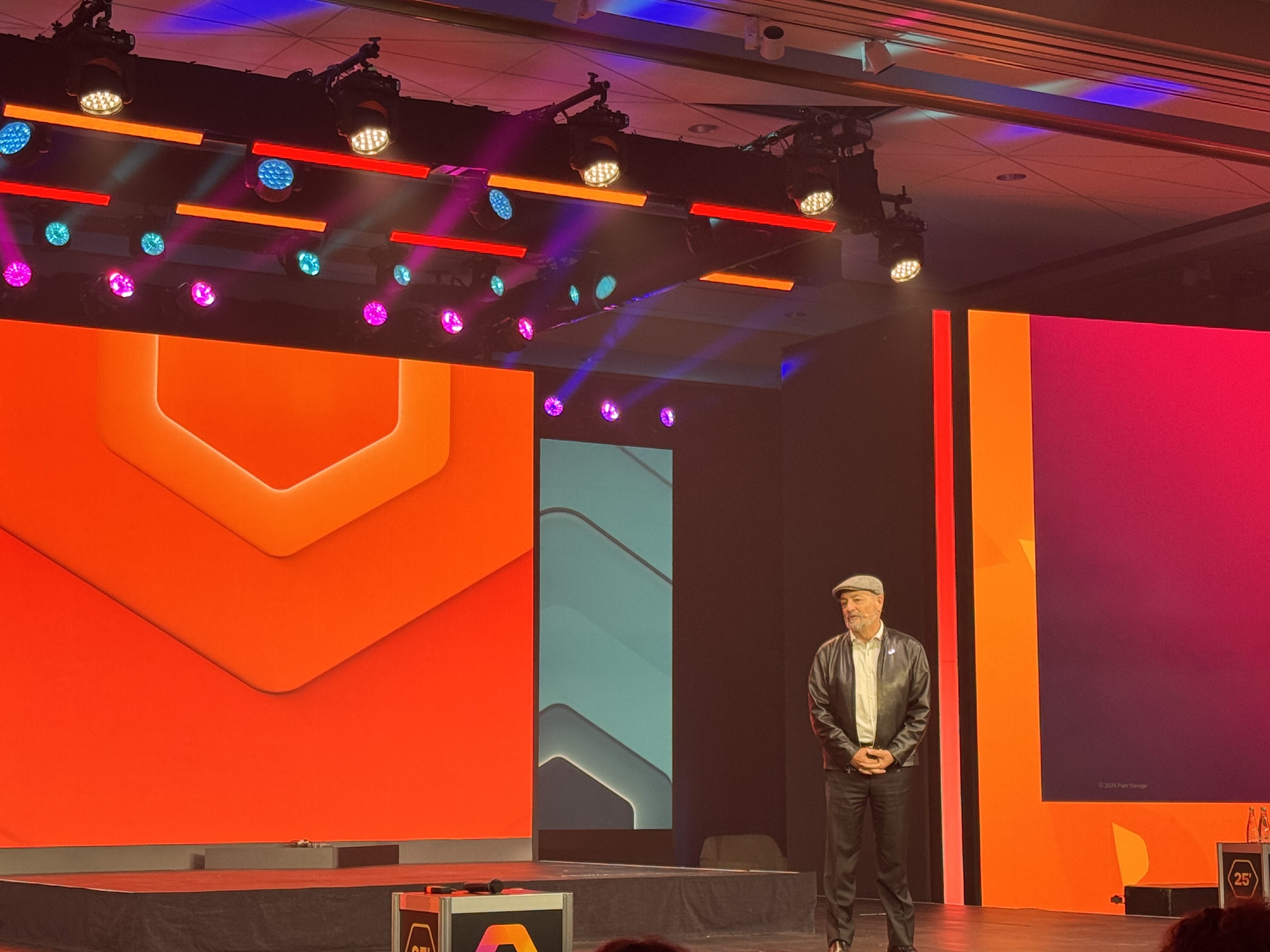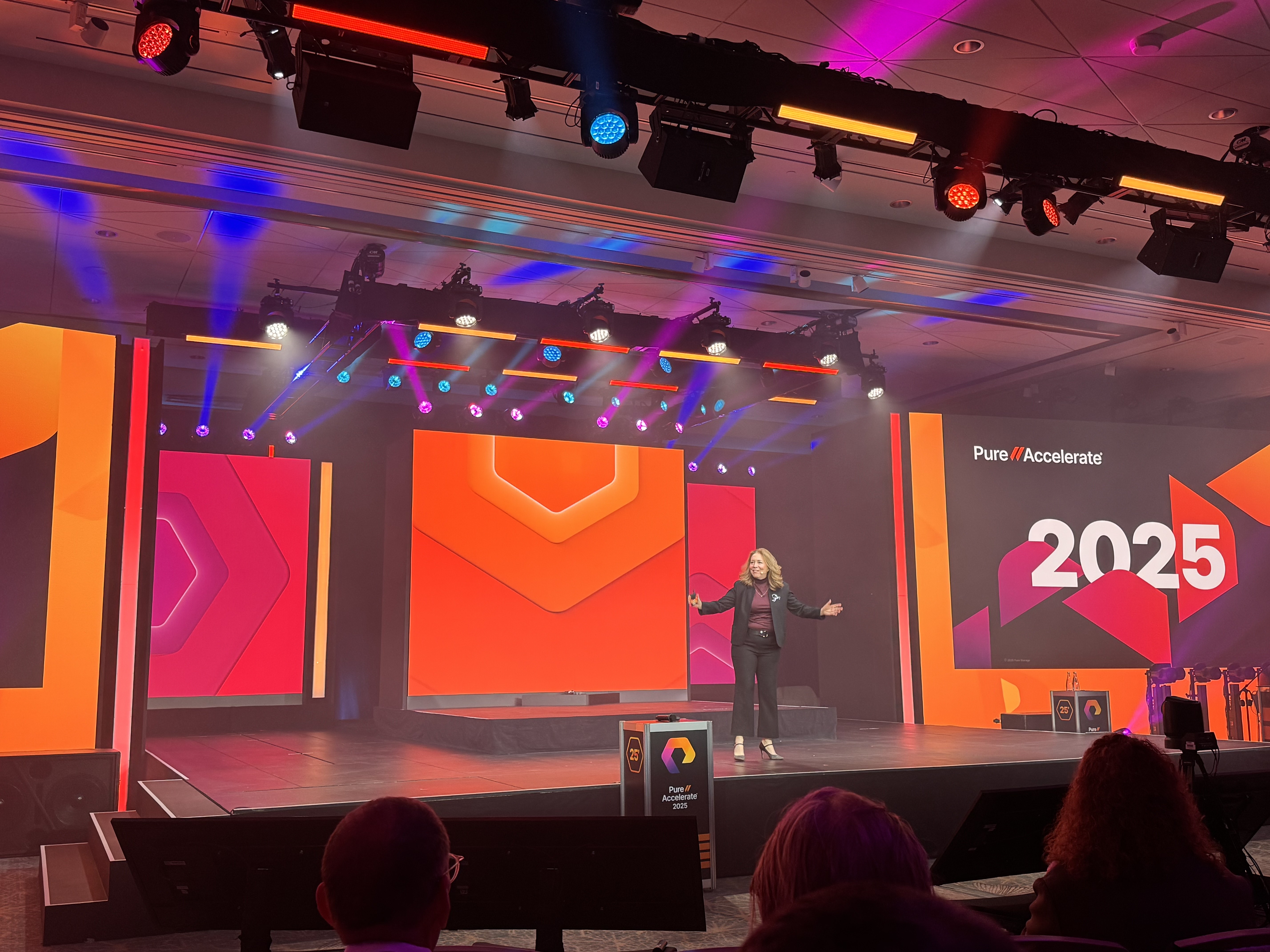All the news and updates live from Las Vegas

Refresh
And with that the opening keynote this week is done and dusted. But that’s not the end of our live coverage at Pure Accelerate. We’ll be back first thing tomorrow morning with the day two keynote.
Keep tabs on our website and the daily newsletter for all the news and updates.
Hansen show that workload provisioning can be drastically improved and simplified just using AI.
“This is science fiction. This is not just automating simple tasks. This is the fact that the AI knew nothing about storage. Everything was pre-encapsulated and existing independently of the underlying storage,” he explains.
“What you just saw was the power of the enterprise data platform with an intelligent control plane,” Hansen adds.
Ultimately, simplification and automation when it comes to infrastructure should be a key focus for enterprises ramping up AI adoption.
Moreover, AI can actually be used to help drive this process, Hansen says.
We’re going to get a demo using Claude by Anthropic to “provision a 5TB machine learning training volume, set up monitoring for it , and run a training simulation to verify it”.
A rather complicated task that could take 6-8 hours for an administrator – Claude did it in no time.
‘As a service’ AI firms are abundant today, Hansen notes. Similarly, self-hosted AI which involves hosting on-prem, is becoming popular.
Both these come with inherent problems. The former often ends up with siloed datasets, Hansen says. The latter, meanwhile, can be clunky and cumbersome to operate.
Rounding things off today we have Shawn Hansen, VP & GM of the Core Platform Business Unit, to talk about AI strategies and the importance of adequate infrastructure in driving success.
(Image credit: Future)
Opting to work with Pure was a “bold decision” but one that’s ultimately paid dividends.
“We’ve improved the performance and reliability by going to Pure. My team’s focus is on other initiatives now – automation and looking at other things.”
So what lies ahead? Containers are a key focus at the moment along with far deeper levels of automation across the business and core operations.
Being a payments company, finserv lives in “constant fear of outages”, and for good reason – that’s a nightmare scenario for the company and customers alike.
The company’s relationship with Pure is close, and long-standing at this point. Reliability is a key factor in this, but also simplicity. Looking ahead, there’s more to come with the partnership.
“We have over 100 incoming arrays and what we’re looking to globally automate routine tasks – that’s what we’re really looking at.”
The company has also reduced its storage footprint by 70% by working with Pure, which has downstream benefits such as general costs and energy consumption.
Now we have a customer up on stage for a chat with Charlie. Fiserv is a key customer for Pure Storage that’s undergone a major overhaul of its data storage infrastructure.
The payments company is one of the biggest in the US, processing 25 million transactions on a daily basis.
Naturally, the company has a big focus on high-performance, reliably infrastructure. The company has also “embraced new technology”, according to Giancarlo.
“We don’t want to stay with the same technology. IN 2019 we started with two storage arrays, and it worked. Now we’re expanding globally, so it’s about being agile, efficient with a fully ready architecture.”
“You get intelligence where you need it. You get a service that guarantees outcomes,” he says.
“We’ve covered a lot this morning,” Naveen says. He’s right. It’s been a rapid fire session.
Now we’re finishing off with a real-world scenario involving a cyber attack. “It’s stressful, it’s chaotic,” he says. “The clock is ticking and you don’t have any answers.”
But with Pure, Naveen says enterprises “have to rethink the problem” – you can’t be having data siloes. Consolidate and unify and with great visibility you can react to incidents in a more efficient manner.
Using Pure’s intelligent control plane is a big advantage here due to the automated tools, disaster recovery, and simplicity.
Snapshot retention is the latest announcement – it’s an add-on to help enterprises beef up the volume of snapshots taken on an annual basis. Big focus on data protection and disaster recovery gains with this.
Now we have Naveen Neelakantam, Chief Architect of digital experiences. Naveen is going to give us a run through the Evergreen//One platform.
“You get operational simplicity. You get a rock solid service with no downtime. We make it easier to free and manage your finances. We give you a risk free experience,” he says.
We have rapid fire announcement here with the new adaptive tier. This is a flexible service aimed at improving scalability and cost-efficiency for enterprises, Naveen says.
There’s now an update to the universal credits service unveiled last year.

(Image credit: Future)
Rob finishes up saying they’re not “building products in isolation” – they’re thinking about products for tomorrow and a unified approach. This is a real ecosystem build out.
“This is the unified platform that you need to build your enterprise data cloud on.”
We’ve also got a big expansion to the object portfolio. The company now has FlashArray object support – there’s a big momentum to this, Rob says.
“You’re going to see us do a lot more in this space in the years to come,” he adds.
Now we’re onto AI and high-performance computing.
“With AI the demands for high performance are growing – and we’re showing our leadership”, Rob says.
The new FlashBlade//S R2 is the company’s latest solution to meet growing enterprise needs in this regard.
70% higher performance than previous generations, so huge gains here.
But what about those looking to the cloud? The company’s partnership with Microsoft allows Pure to deliver the same services on-prem as on Azure.
Later this year, they expect to have a fully managed VMware service in Azure , Rob says.
Now we’re moving onto virtualizing options, starting with optimizing VMware.
The company has a deep history of VMware integrations, Rob says. With the XL R5 there are big efficiency improvements now.
But for those looking at alternatives, there’s an expanded partnership with Nutanix. This will combine the Nutanix cloud platform with the FlashArray line to “deliver the best of both world’s” according to Rob.
A big boon for architecture simplicity. The early access program is already oversubscribed, so there’s certainly a big appetite for this.
We have another announcement here, the FlashArray//ST, or ‘FAST’, as Rob mentions. It’s a beast that’s “only going to get faster” from current levels – 10 million IOPS and 8gbps throughput.
High-performance hardware plays a key role in keeping the lights on, Rob says. The new FlashArray//XL R5 “redefines” high performance block storage, Lee says.
This delivers 300% more IOPS compared to competitors, as well as 10x more reliable.
Next up we have CTO Rob Lee taking to the stage. Rob is here to give us a rundown of the enterprise data cloud.
We’re looking at key priorities for enterprises today, including protecting mission critical systems and AI.

(Image credit: Future)
This will “change the way you do storage management”, Kennedy says.
From a productivity standpoint, Pure’s AI Copilot plays a big role in streamlining processes for administrators.
He uses the example of a missed backup window. But with hundreds of arrays, that’s like finding a needle in a haystack. With the Copilot though, users can query this using natural language to identify and troubleshoot the cause of the problem.
Now we’ve tackled the infrastructure and operations aspects, Kennedy wants to dive into the compliance considerations.
Kennedy points to the development of a Data Intelligence Engine – this offers data insights for users, data cataloguing. This will be integrated within Pure1, Kennedy notes.
Paired with this is the compliance reporting engine that’s still under development. This will offer real-time alters and automated remediation.
This is also integrated with Slack to provide progress updates – helping to improve visibility.
We’ve also got a new workflow orchestrator. This is an extension of Fusion, but within software environments, Kennedy notes.
“We can extend our automation intelligence beyond just storage to software environments”.
We’re getting another demo now to create a new SQL database. Again it’s a speedy process here with a few “intelligent connected steps” – seven in total.
We’re getting a live demo of workload placements now, and it’s a very speedy process, fully provisioned, and secured.
It’s essentially a few clicks working with Fusion to streamline the process.
“This amazing technology works great within the pure storage ecosystem,” Kennedy says. But they’re also building it for outside the Pure ecosystem, like VMware, which now has Pure Fusion presets.
Integration with Rubrik is a big talking point for Fusion and the EDC, Kennedy says. This will help bolster threat detection and disaster recovery.
So how does this work from an operational perspective?
Pure Fusion offers users ‘presets’ which allows users to streamline workloads and optimize workload placements.
Next up we have Chadd Kennedy, VP of product marketing at Pure Storage. Chadd will be giving us a rundown of the intelligent control plane now in operation at the company.
Chadd makes the point that this intelligent control plane has been tried before. From observability platforms to storage virtualization to automation platforms. They all lack one thing though – intelligence.
“Over the last 13 years and tens of thousands of systems, we’ve been consolidating some of the largest systems of telemetry data out there,” Kennedy says.
Pure has been working on this for over a decade to help automate and allow enterprises to better understand their data center architectures.
They’re using this data and expertise to essentially streamline and automate large swathes of the enterprise storage estate.

(Image credit: Future)
Autonomous data governance is a key talking point here and something that will be highly beneficial to businesses operating globally. You’re reducing manual toil significantly by automating this process.
“This is a major change in the way you handle your data,” Giancarlo says.
“When you build your enterprise data cloud you can stop managing your storage and start managing your data on a global basis”
So how does this work?
With the Data Cloud, there’s a greater degree of automation compared to captive arrays, which are operated manually.
With the Enterprise Data Cloud, you’re going to a “virtual cloud of storage” and a “consistent environment across your global network”.
“In order to better manage your data in an enterprise environment, you need to start with a unified data plane.”
Now we’ve got the big reveal – ‘Fusion;. What this does is creates a “new intelligent control plane,” Giancarlo says. This is a huge announcement from the company – it allows all of its arrays to be managed as a fleet in a cloud-like manner.
“It allows you to define how you want your different datasets to be managed on a global basis. It’s not about clusters, about allowing a few arrays to work together. It’s about a global cloud with available zones in different regions,” he says”.
There are huge advantages here in terms of governance, compliance, and security, the company says.
So how does that compare to the cloud? Enterprise storage architectures are vertical, Giancarlo says. Cloud storage architectures are horizontal, and the latter of these is far more efficient and streamlined.
This has been the big focus for Pure and Giancarlo. The company wants to simplify data center architectures and creating a “much more consistent environment, a much more automated environment”.
This is where Purity, its software-defined foundation, which offers a common operating environment.
Enterprise data center architectures are inherently flawed when it comes to accommodating AI, Giancarlo says. Arrays are managed and provisioned individually, and the data is “captive to the application stack”.
What this essentially means is enterprises now face disparate, siloed datasets, which hampers innovation and efficiency.
Moreover, data governance is also sporadic as it’s applied manually in separate areas by individual areas of the business based on specific requirements.
Giancarlo is now examining ‘AI in the real world’ – flashy numbers and stats on GPU clusters are all fine and well, but how is this technology helping enterprises on the ground?
“AI is going to change the relationship between software and data,” he says. Looking back, software was eating the world, but that’s all changing, Giancarlo says.
The technology is having a transformative impact across the enterprise and consumer space – and that means data is now more important than software, it’s the lifeblood that underpins the technology. Without it, the engines fail.

(Image credit: Future)
With AI workloads posing a big problem for enterprises, Pure is dialing in on this challenge – the new FlashBlade//EXA series addresses this directly, offering “complete AI scale coverage” for users.
Pure is now designing the next generation of data centers for Meta, a big win for the company. The appeal for Meta comes from Purity and DirectFlash, according to Giancarlo, and will enable Meta to drastically improve data center efficiency and reduce energy consumption.
“DirectFlash doesn’t operate as SSDs do, as a substitution for hard disks,” he says.
“Meta can now go all flash in their data centers, reduce their power and footprint by 20%”
CEO Charlie Giancarlo takes to the stage now, and we’re going to hear about the company’s long-term strategy – expect to hear a lot about the new Enterprise Data Cloud. It’s the big talking point this week so far.
“We, Pure, have grown consistently every single year. The fastest grower, and in some cases the only grower, in our industry.”
Revenue at Pure now sits at $3.2bn, with a 17% operating margin.
50% of revenue is now in subscriptions, Giancarlo says, and it’s a point of pride for the company.

(Image credit: Future)
Lynn Lucas, CMO at Pure Storage kicks things off today at Pure Accelerate.
Getting things going here, Lucas mentions the talk of the town over the last two years, AI. It’s prompted huge changes for Pure and today we’ll expect to hear a whole lot on how they plan to support enterprises ramping up adoption.

(Image credit: Future)
The keynote hall is filling up quickly now here at Resorts World, we’ve got around five minutes to go until things kick off – the music is blaring out.

(Image credit: Future)
Elsewhere, we’ve had some hardware news from Pure Storage, with new FlashBlade and FlashArray series updates. The company has touted the big performance boosts across its all-flash products, with a particular focus placed on high intensity workloads.
You can find more on the updates below.
• Pure Storage beefs up FlashBlade, FlashArray offerings in platform performance focus
We’ve got just over an hour until the opening keynote session kicks off, where we’ll be hearing from Pure Storage CEO Charlie Giancarlo and the executive team.
There’s been a lot of activity at Pure Storage over the last year, and we’ve already had a big announcement drop with the launch of the company’s Enterprise Data Cloud (EDC).
ITPro caught up with Giancarlo yesterday to talk about the new data cloud and the company’s platform-focused strategy.
You can check that out below.
• Pure Storage unveils Enterprise Data Cloud in bid to unify data storage, management
Source link











